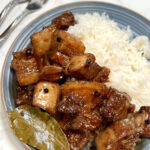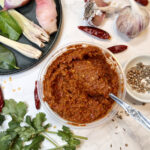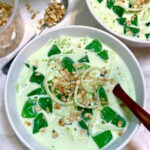Pancit Bihon is a special Filipino dish packed with chewy rice noodles and tons of vegetables and proteins. Served mainly in celebrations, it was thought that the longer the pancit noodle, the longer your life will be!
I’ve been running this blog for a little almost a year now, and I’m JUST about getting to this staple Pinoy recipe after so many requests! I just had to be sure I got the ratios right for this recipe, so who better to consult than my own dad, who’s specialty is making his famous pancit?
He would typically just eyeball all the ingredients for pancit, but it would taste delicious every time. For that reason, playing around with the specific measurements for the veggies, proteins, and sauce were a slight pain since I had to do so many trial runs for the recipe (hence why I’ve been stuffed full of noodles these past couple weeks).

What is Pancit?
Pancit is one of the most famous Filipino foods, next to lumpia or adobo. It was originally brought to the Philippines through Chinese immigrants, and over decades has become a Filipino staple that catered to local tastes.
Pancit is a general term that encompasses a wide variety of regional variants, all depending on the type of noodle used. For this recipe, we’re using bihon noodles, a type of chewy, stringy, and thin Filipino noodle. Other variants include Pancit Canton (which uses thick wheat noodles) or Pancit Malabon (which uses thick rice noodles and lots of seafood).

My dad’s version can be broken up into 3 steps: cook the proteins, stir fry the veggies, and soften the noodles in the broth. All of these components are then tossed together to make a hearty, filling, and savory noodle dish that’s perfect for any day of the week or for special occasions.
Ingredients for Pancit Bihon
Bihon noodles: Bihon are thin, chewy, noodles either made from rice or cornstarch that can be found in most Filipino convenience stores or even in your local Asian supermarket. My family always uses the “Super Q” brand since their noodles do a great job in remaining chewy and not overly breaking down in the stir fry.
Soy sauce, dark soy sauce, oyster sauce, sugar, ground black pepper, calamansi juice, water, chicken bouillon cube: This will form the basis for our pancit sauce. Some recipes would instruct you to soften the noodles beforehand by soaking them in water, but you get TONS more flavor when you soften the noodles directly into the sauce since they absorb all of the seasoning.
Garlic, onion, cabbage, celery leaves, carrot, snap peas: We’ll be stir frying these veggies slightly, just enough until they soften, but still retaining a slight crunch when we toss it in with the bihon noodles.
Pork belly/chicken, Chinese sausage, shrimp: These will be the main proteins used for our pancit. Feel free to omit or add any ingredients to suit your preferences.
Instructions for Pancit Bihon
Prepare the proteins
In a wok or large pan over medium heat, gently fry the pork belly until most of the fat has rendered off and it has become browned in color, about 7-10 minutes. Set aside.

Briefly fry the shrimp for 2-3 minutes until just cooked through, set aside.

Prepare the vegetables
In the same wok over medium heat, add 1 tbsp of oil. Saute the the onions until softened, about 3-5 minutes.
Add in the garlic and Chinese sausage, and continue to saute until the garlic is golden and fragrant, about 2 minutes.

Add in the cabbage, carrots, and snap peas. Stir fry for about 5 minutes, tossing frequently, until the vegetables have slightly softened, set aside.

Prepare the noodles
In a bowl, mix together the hot water, chicken bouillon cube, soy sauce, oyster sauce, dark soy sauce, sugar, calamansi juice, and ground black pepper until combined and the chicken bouillon cube has completely dissolved.

Pour the sauce mixture into the wok and bring to a boil. Once boiling, add in the dried bihon noodles and lower the heat to medium low. Let the bihon noodles soak up the sauce, stirring occasionally, until they soften and all the sauce has been absorbed, about 5 minutes.


Toss in the reserved proteins, stir-fried vegetables, and a handful of celery leaves. Gently mix everything together until fully combined. Season to taste with more salt and pepper, if desired.

Serve warm with calamansi juice on the side. Enjoy!

Looking for more delicious noodle dishes? Here’s a couple more you might love:
- Creamy Sesame Noodles
- Yaki Udon (Japanese Stir-Fried Udon Noodles)
- Spicy Chili Oil Noodles
- Salted Egg Noodles
Disclosure: Some links on this page are affiliate links, meaning that at no additional cost to you, we may receive compensation from purchases made through these links. As an Amazon Associate, I can earn from qualifying purchases.








Pingback: Shrimp Sinigang (Sinigang na Hipon) | Iankewks
Pingback: Steak Donburi | Iankewks
Pingback: Chili Peanut Noodles | Iankewks
💯💯💯🥰
Pingback: Dynamite Lumpia | Iankewks
Pingback: Pork Adobo (adobong baboy) | Iankewks